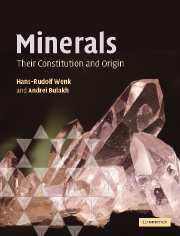Book contents
- Frontmatter
- Contents
- Preface
- Acknowledgments
- Figure credits
- Part I Structural features of minerals
- Part II Physical investigation of minerals
- Part III Variety of minerals and mineral-forming processes
- Part IV A systematic look at mineral groups
- 19 Important information about silica materials and feldspars
- 20 Simple compounds. Unusual mineral occurrences
- 21 Halides. Evaporite deposits
- 22 Carbonates and other minerals with triangular anion groups. Sedimentary origins
- 23 Phosphates, sulfates, and related minerals. Apatite as a biogenic mineral
- 24 Sulfides and related minerals. Hydrothermal processes
- 25 Oxides and hydroxides. Review of ionic crystals
- 26 Orthosilicates and ring silicates. Metamorphic mineral assemblages
- 27 Sheet silicates. Weathering of silicate rocks
- 28 Chain silicates. Discussion of some igneous and metamorphic processes
- 29 Framework silicates. Zeolites and ion exchange properties of minerals
- Part V Applied mineralogy
- Appendices
- Glossary
- References
- Index
- Plate section
- References
27 - Sheet silicates. Weathering of silicate rocks
from Part IV - A systematic look at mineral groups
- Frontmatter
- Contents
- Preface
- Acknowledgments
- Figure credits
- Part I Structural features of minerals
- Part II Physical investigation of minerals
- Part III Variety of minerals and mineral-forming processes
- Part IV A systematic look at mineral groups
- 19 Important information about silica materials and feldspars
- 20 Simple compounds. Unusual mineral occurrences
- 21 Halides. Evaporite deposits
- 22 Carbonates and other minerals with triangular anion groups. Sedimentary origins
- 23 Phosphates, sulfates, and related minerals. Apatite as a biogenic mineral
- 24 Sulfides and related minerals. Hydrothermal processes
- 25 Oxides and hydroxides. Review of ionic crystals
- 26 Orthosilicates and ring silicates. Metamorphic mineral assemblages
- 27 Sheet silicates. Weathering of silicate rocks
- 28 Chain silicates. Discussion of some igneous and metamorphic processes
- 29 Framework silicates. Zeolites and ion exchange properties of minerals
- Part V Applied mineralogy
- Appendices
- Glossary
- References
- Index
- Plate section
- References
Summary
Structural features
The next group of silicate minerals that we discuss are sheet silicates, also called phyllosilicates (after the Greek φυλλον (phyllon, meaning leaf)). Most of the minerals in this group have a flaky habit and an excellent single cleavage. The habit and cleavage are due to planar units in the crystal structure. All sheet silicates contain, in addition to O2-, OH- groups as anions.
We mentioned in Chapter 26 that silicon tetrahedra (SiO4-4) in sheet silicates are polymerized to form an infinite two-dimensional net with six-membered rings and hexagonal symmetry (Figure 27.1). Contrary to the tetrahedral nets of tridymite and cristobalite, where alternating apices point in opposite directions (and are linked to another net) (Figure 19.3a), in sheet silicates all free tetrahedral apices point in the same direction. Within a sheet silicate net, three corners of each tetrahedron are shared with another, resulting in a structural base of the tetrahedral network Si2O52-. Such a layer has a negative charge that is neutralized by interstitial layers of cations and anions.
The distance between free oxygen apices in a net is close to 1.3 Å, and this value is very similar to the O–O distance of a coordination octahedron (1.4 Å). Therefore the tetrahedral layer fits almost perfectly on top of a layer of octahedra that lie on triangular sides and share edges (Figure 27.2a). As the tetrahedral layer is attached to the octahedral layer, corresponding oxygen atoms are shared.
- Type
- Chapter
- Information
- MineralsTheir Constitution and Origin, pp. 448 - 469Publisher: Cambridge University PressPrint publication year: 2004



